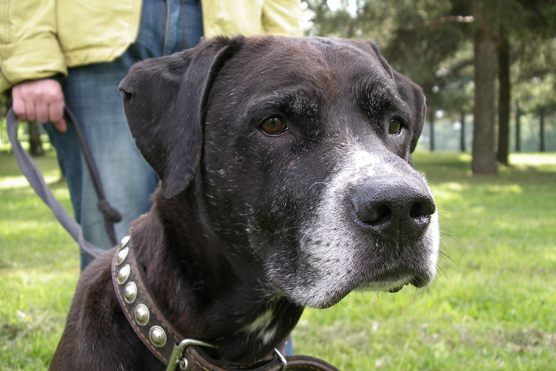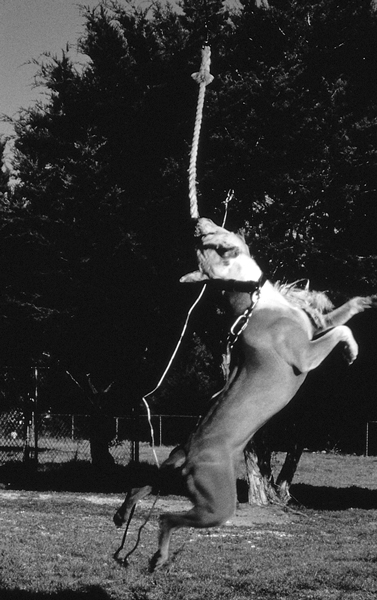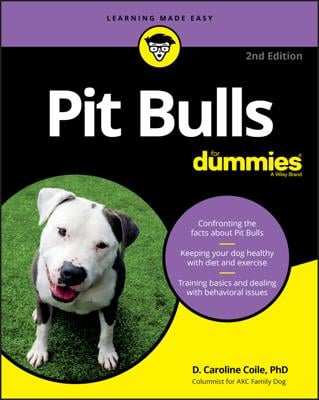 © Yurykara / Shutterstock.com
© Yurykara / Shutterstock.comFew things are as adorable as a mischievous Pit Bull pup discovering the world, or as magnificent as an adult Pit Bull exuding self-confidence, but other Pit Bulls pale in comparison to the wise and stately Pit Bull elder.
Older Pit Bulls can enjoy full and active lives, as long as you know what extra measures to take.
Average life expectancy for a Pit Bull is about 11 to 13 years, although many have reached ripe old ages of 15 or 16.
Eat and run
Many Pit Bull owners have the idea that their macho little dog won’t ever slow down with age. But staying in a state of denial about your dog’s increasing age or decreasing abilities is not doing him any favors.Older Pit Bulls, who may have had minor joint problems when young, really begin to suffer from them. Keeping your older Pit Bull relatively active, without putting too much stress on his joints, is critical to his health. If your dog is sore the day after you exercise, you’ve probably asked too much. You may have to walk with your dog and do your marathon running by yourself. Swimming is an excellent low-impact exercise, as long as the dog doesn’t get chilled and is never put in a dangerous situation. Remember that exercise is essential to keeping your dog healthy and happy.
 Older Pit Bulls still need an active lifestyle to stay healthy.
Older Pit Bulls still need an active lifestyle to stay healthy.Older dogs should be fed several small meals instead of one large meal, and should be fed on time. Moistening dry food or feeding canned food can help a dog with dental problems enjoy his meal. He may also enjoy eating while lying down or eating off of a raised platform.
Older dogs engage in less physical activity and have lower metabolic rates, so they require fewer calories than they used to. Older dogs who are fed the same amount of food as when they were young can become obese; obese dogs have a greater risk of cardiovascular and joint problems.
Some Pit Bulls lose weight with age, which can be as unhealthy as gaining weight. Your dog needs a little bit of padding, so that he has something to fall back on if he gets sick. Consuming high quality (not quantity) protein is especially important for older dogs. The good news is that most older dogs do not require a special diet unless they have a particular medical need for it.
Act your age
Older dogs tend to like a simple life. Although they’re still up for adventure, that adventure may have to be toned down a bit. Long trips can be grueling for an older dog, and boarding in a kennel may be extremely upsetting. Consider getting a house sitter who your dog knows if you want to go on vacation.Some older dogs become cranky and impatient, especially when dealing with puppies or boisterous children. But don’t excuse behavioral changes, especially if they’re sudden, as entirely due to aging. They could be symptoms of pain or disease.
The slight haziness that appears in an older dog’s pupils is normal and has minimal effect upon vision, but some dogs, especially those with diabetes, may develop cataracts. Cataracts can be seen through the dog’s pupils as a densely clouded area. The lens can be removed by a veterinary ophthalmologist if the cataract is severe. Older dogs may experience hearing or visual loss. Be careful not to startle a dog with impaired senses, as a startled dog could snap in self-defense.
Dogs with gradual vision loss can cope well, as long as they are kept in familiar surroundings and extra safety precautions are followed. For example, don’t move furniture, and place sound or scent beacons throughout the house or yard to help the dog locate specific landmarks. Also lay pathways in the yard, such as gravel or block walkways, and even in the house, using carpet runners. Block open stairways or pools. Dogs with hearing loss can learn hand gestures and also respond to vibrations.
The immune system may be less effective in older dogs. As a result, shielding your dog from infectious disease, chilling, overheating, and any other stressful condition is important. A bit of good news: An older dog who’s never exposed to other dogs may not need to be vaccinated as often or for as many diseases as a younger dog. Discuss this with your veterinarian.
Vomiting and diarrhea can signal that an older dog may have various problems; keep in mind that an older dog cannot tolerate the dehydration that results from continued vomiting or diarrhea. You should not let it continue unchecked.
An older Pit Bull should see the veterinarian at least twice a year. Blood tests can detect early stages of diseases, and your vet may be able to spot developing problems without any tests whatsoever.
Older dogs are somewhat more at risk when they undergo anesthesia. Most of the increased risk can be negated, however, by carefully screening dogs to determine if they’re healthy enough to undergo the procedure. Many older dogs need tooth cleaning under anesthesia — this is generally safe, as long as your dog is healthy.Older dogs tend to have a stronger body odor. Don’t just ignore increased odors, though. They could indicate specific problems, such as periodontal disease, impacted anal sacs, seborrhea, ear infections, or even kidney disease. Any strong odor should be checked by your veterinarian.
Like people, dogs lose skin moisture as they age. Although dogs don’t have to worry about wrinkles, their skin can become dry and itchy. Regular brushing can help to stimulate oil production.
Although Pit Bulls of any age enjoy a soft, warm bed, such a bed is an absolute necessity for older Pit Bulls. Arthritis is a common cause of intermittent stiffness and lameness, and it can be helped with heat, a soft bed, moderate exercise, and possibly drug therapy. New arthritis medications have made a huge difference in the quality of life for many older Pit Bulls, but not every dog can use them. Ask your veterinarian to evaluate your dog’s ability to take some of the new medicines, if your Pit has arthritis.
In general, any ailment that an older dog has is magnified in severity on account of age. Some of the more common symptoms of illness that an older Pit Bull may display, and the possible causes of the symptoms, include:
- Diarrhea: kidney or liver disease; pancreatitis
- Coughing: heart disease; tracheal collapse; lung cancer
- Difficulty eating: periodontal disease; oral tumors
- Decreased appetite: kidney, liver, or heart disease; pancreatitis; cancer
- Increased appetite: diabetes; Cushing’s syndrome
- Weight loss: heart, liver or kidney disease; diabetes; cancer
- Abdominal distention: heart or kidney disease; Cushing’s syndrome; tumor
- Increased urination: diabetes; kidney or liver disease; cystitis; Cushing’s syndrome
- Limping: arthritis; hip or elbow dysplasia; degenerative myelopathy
- Nasal discharge: tumor; periodontal disease
When you’ve done everything
Despite the best of care, a time will come when neither you nor your veterinarian can prevent your dear friend from succumbing to old age or an incurable illness. It seems hard to believe that you will have to bid farewell to an animal who has been such a focal point of your life—in truth, a real member of your family. That dogs live such a short time compared to humans is a cruel fact, but one that you must ultimately face.You should realize that both of you have been fortunate to share so many good times. You must also make sure that your Pit Bull’s remaining time is still pleasurable. Many terminal illnesses make your dog feel very ill, and there comes a point when your desire to keep your friend with you for as long as possible may be cruel to both of you. If your dog no longer eats his dinner or treats, he’s giving you a sign that he doesn’t feel well and you must face the prospect of doing what’s best for your beloved friend.
Every Pit Bull owner has to determine when they feel the point has come, using whatever criteria they feel is right. In my opinion, many people put off making the difficult choice for longer than they should and for longer than is kind to the dog. They don’t want to act in haste and be haunted by thoughts that, just maybe, the most recent dip into lethargy and illness was a temporary setback. And of course, they put it off because they can’t stand the thought.
Euthanasia is a difficult and personal decision that no one wishes to make, and no one can make it for you. Ask your veterinarian if there is a reasonable chance of your dog getting better and if your dog is likely suffering. Ask yourself if your dog is getting pleasure out of life, and if he enjoys most of his days. Financial considerations can be a factor too, if you’d have to go into debt to keep your dog alive for just a bit longer. Your own emotional state must also be considered.
We all wish that, if our dog has to go, he could just fall asleep and never wake up. This, unfortunately, almost never happens. Even when it does, you’re left with the regret that you never got to say goodbye. The best way you can simulate a natural death is with euthanasia. Euthanasia is painless and involves giving an overdose of an anesthetic. The dog falls asleep and dies almost instantly. In a very sick dog, because the circulation is compromised, it may take slightly longer for the anesthetic to go into effect.
If you do decide that euthanasia is the kindest thing you can do for your beloved friend, discuss with your veterinarian what will happen. You may ask about giving your dog a tranquilizer beforehand, if he’s afraid of the vet’s office. You may feel better having the doctor meet you at home or if the vet comes out to your car. Although it won’t be easy, try to remain with your dog so that his last moments will be filled with your love; otherwise, have a friend whom your dog knows stay with him. Try to recall the wonderful times you’ve shared, and realize that, however painful losing such a once-in-a-lifetime dog is, it’s better than never having had such a partner at all.
Eternally in your heart
After losing such a cherished friend, many people say that they will never get another dog. True, no dog will ever take the place of your dog. But you’ll find that another dog is a welcome diversion and will help keep you from dwelling on the loss of your first pet, as long as you don’t keep comparing the new dog to the old. It’s true that by getting another dog you’re sentencing yourself to the same grief in the future, but wouldn’t you rather have that than miss out on a second once-in-a-lifetime dog?The loss of your companion may mark the end of an era for you, a time when you and your Pit Bull grew up or grew old together. But one could scarcely ask for a better life partner than a special Pit Bull. As long as you hold your memories close, your relationship with your dog will last forever.

